
A smartphone is a mobile device that combines the functionality of a traditional mobile phone with advanced computing capabilities. It typically has a touchscreen interface, allowing users to access a wide range of applications and services, such as web browsing, email, and social media, as well as multimedia playback and streaming. Smartphones have built-in cameras, GPS navigation, and support for various communication methods, including voice calls, text messaging, and internet-based messaging apps.
Google Nexus is a discontinued line of consumer electronic devices that run the Android operating system. Google managed the design, development, marketing, and support of these devices, but some development and all manufacturing were carried out by partnering with original equipment manufacturers (OEMs). Alongside the main smartphone products, the line also included tablet computers and streaming media players; the Nexus started out in January 2010 and reached its end in October 2016, replaced by Google Pixel.
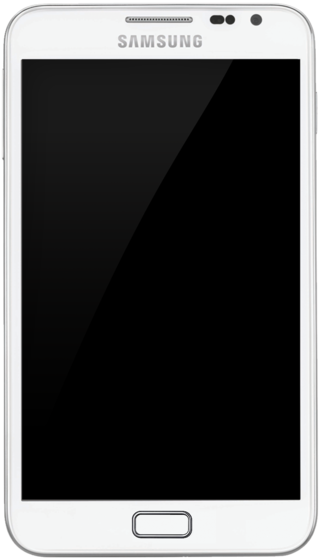
The Samsung Galaxy Note is an Android smartphone produced by Samsung Electronics. It was unveiled at IFA Berlin 2011 and first released in Germany in late October 2011, with other countries following afterwards. The Galaxy Note was distinguished by its unusually large form factor—later referred to using the term "phablet"—which straddled the size of the average smartphone at the time, and that of a small tablet: it features a 5.3-inch display, and is bundled with a stylus branded as the "S Pen", which can be used to navigate the device's user interface, and write or draw in supported apps.
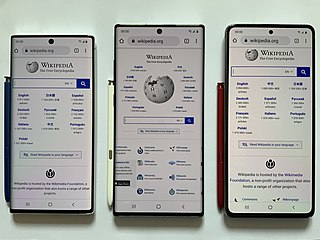
A phablet is a mobile device combining or straddling the size formats of smartphones and tablets. The word is a portmanteau of phone and tablet. The term is largely obsolete by the late 2010s, since average smartphone sizes eventually morphed into small tablet sizes, up to 6.9 inches (180 mm), with wider aspect ratios.

The Samsung Galaxy S series is a line of flagship Android smartphone and tablet computer produced by Samsung Electronics. In conjunction with the foldable Galaxy Z series, the lineup serves as Samsung's flagship smartphone lineup.
Google Pixel is a brand of portable consumer electronic devices developed by Google that run either ChromeOS or the Android operating system. The main line of Pixel products consist of Android-powered smartphones, which have been produced since October 2016 as the replacement of the older Nexus, and of which the Pixel 8 and 8 Pro are the current models. The Pixel brand also includes laptop and tablet computers, as well as several accessories, and was originally introduced in February 2013 with the Chromebook Pixel.

The Samsung Galaxy Note series was a line of high-end flagship Android phablets and smartphones developed and marketed by Samsung Electronics. The line is primarily oriented towards pen computing; all Galaxy Note models shipped with a stylus pen, called the S Pen, and incorporate a pressure-sensitive Wacom digitizer. All Galaxy Note models also include software features that are oriented towards the stylus and the devices' large screens, such as note-taking, digital scrapbooking apps, tooltips, and split-screen multitasking. The line served as Samsung's flagship smartphone model, positioned above the Galaxy S series.

The Samsung Galaxy S7, Samsung Galaxy S7 Edge and Samsung Galaxy S7 Active are Android-based smartphones manufactured, released and marketed by Samsung Electronics. The S7 series serves as the successor to the Galaxy S6, S6 Edge, S6 Edge+ and S6 Active released in 2015. The S7 and S7 Edge were officially unveiled on 21 February 2016 during a Samsung press conference at Mobile World Congress, with a European and North American release on 11 March 2016. The S7 Active was unveiled on 4 June 2016, and released on AT&T in the United States on 10 June 2016.
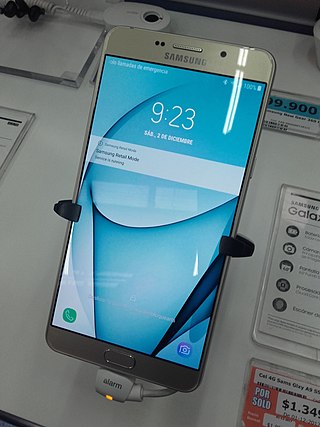
The Samsung Galaxy A9 Pro (2016) is an Android smartphone produced by Samsung Electronics. It was introduced in March 2016.
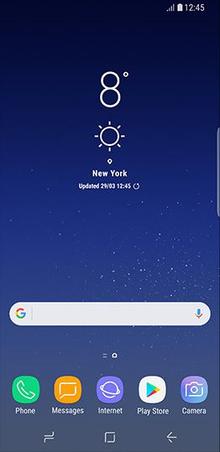
Samsung Experience is a discontinued software overlay for the Android "launcher" by Samsung for its Galaxy devices running Android 7.x “Nougat” and Android 8.x “Oreo”. It was introduced in late 2016 on a beta build based on Android 7.0 “Nougat” for the Galaxy S7, succeeding TouchWiz. It has been succeeded in 2018 by One UI based on Android 9 “Pie” and later versions.
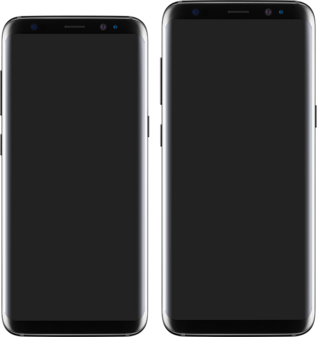
The Samsung Galaxy S8 and Samsung Galaxy S8+ are Android smartphones produced by Samsung Electronics as the eighth generation of the Samsung Galaxy S series. The S8 and S8+ were unveiled on 29 March 2017 and directly succeeded the Samsung Galaxy S7 and S7 Edge, with a North American release on 21 April 2017 and international rollout throughout April and May. The Samsung Galaxy S8 Active was announced on 8 August 2017 and is exclusive to certain US cellular carriers.
The Pixel 2 and Pixel 2 XL are a pair of Android smartphones designed, developed, and marketed by Google as part of the Google Pixel product line. They collectively serve as the successors to the Pixel and Pixel XL. They were officially announced on October 4, 2017 at the Made by Google event and released in the United States on October 19. On October 9, 2018, they were succeeded by the Pixel 3 and Pixel 3 XL.
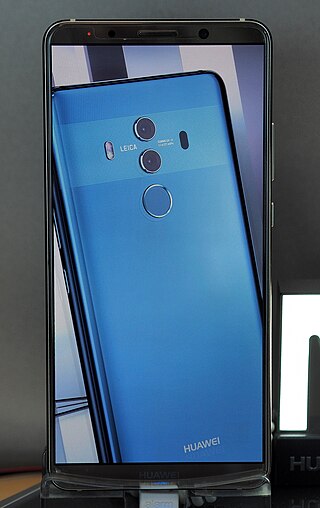
The Huawei Mate 10, Huawei Mate 10 Pro and Huawei Mate 10 Lite are Android smartphones designed and marketed by Huawei as part of the Huawei Mate series. There is also a Mate 10 Porsche design, which has 256Gb of storage but is otherwise identical to the Mate 10 Pro. They were first released on 16 October 2017. Versus the predecessor Mate 9, the Mate 10 pro flagship phone has a faster processor with an integrated neural processing unit, a slightly larger OLED screen (6.0") with a taller 18:9 aspect ratio, a significantly longer battery life and a glass back construction. Chinese and international models are available in dual SIM configuration. It comes with Android 8 and a newer version of Huawei's EMUI interface. All Mate 10 models are unlocked and GSM only. Huawei phones, including the Mate series, are not sold or financed through U.S. carriers due to pressure from U.S. intelligence agencies, though they are available from independent and online retailers.

The Samsung Galaxy S9 and S9+ are Android-based smartphones unveiled, manufactured, released and marketed by Samsung Electronics as part of the Samsung Galaxy S series. The devices were revealed at the Mobile World Congress in Barcelona on 25 February 2018, as the successors to the Samsung Galaxy S8 and S8+.
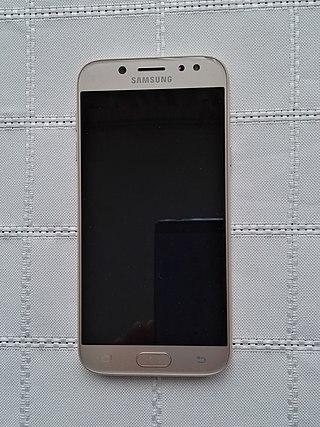
Samsung Galaxy J5 2017 is an Android-based smartphone produced, released and marketed by Samsung Electronics. It was unveiled and released in July 2017 along with the Samsung Galaxy J3 (2017). It has an advanced 64-bit class system on a chip (SoC) backed by 2 GB or 3 GB Of LPDDR3 RAM. It packs a Non-removable 3000 mAh battery. The Galaxy J5 (2017) is the successor to the Samsung Galaxy J5 (2016).

The Samsung Galaxy Note 9 is an Android-based phablet designed, developed, produced and marketed by Samsung Electronics as part of the Samsung Galaxy Note series. It was unveiled on 9 August 2018, as the successor to the Samsung Galaxy Note 8. It is available in six colours.

The Samsung Galaxy S10 is a line of Android-based smartphones manufactured, released and marketed by Samsung Electronics as part of the Samsung Galaxy S series. The Galaxy S10 series is the tenth generation of the Samsung Galaxy S, its flagship line of phones next to the Note models, which is also the 10th anniversary of the Galaxy S. Unveiled during the "Samsung Galaxy Unpacked 2019" press event held on 20 February 2019, the devices started shipping in certain regions such as Australia and the United States on 6 March 2019, and internationally on 8 March 2019.
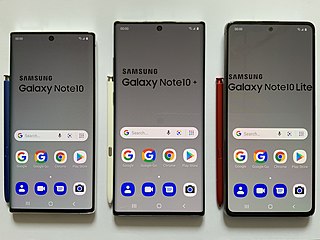
The Samsung Galaxy Note 10 is a line of Android-based phablets designed, developed, produced, and marketed by Samsung Electronics as part of the Samsung Galaxy Note series. They were unveiled on 7 August 2019, as the successors to the Samsung Galaxy Note 9. Details about the phablets were widely leaked in the months leading up to the phablets' announcement.

The Samsung Galaxy A90 5G is an Android phablet manufactured by Samsung Electronics as part of its fifth-generation Galaxy A series lineup. It comes with Android 9 (Pie) with Samsung's One UI skin, 6/8GB RAM, 128 GB of internal storage, and a 4500 mAh battery. It is Samsung's first mid-range smartphone to support 5G network connectivity. The Galaxy A90 5G was first unveiled in South Korea on September 3, 2019.

In January 2, 2017, Samsung unveiled the 2017 edition of the Galaxy A series, comprising three models. This move marks Samsung's first product launch since the discontinuation of the Galaxy Note 7 back in October 2016. Following the unveiling, Samsung announced that they would sell up to 20 million smartphones, targeting Western and Eastern Europe, Africa, Asia, and Latin America.


















